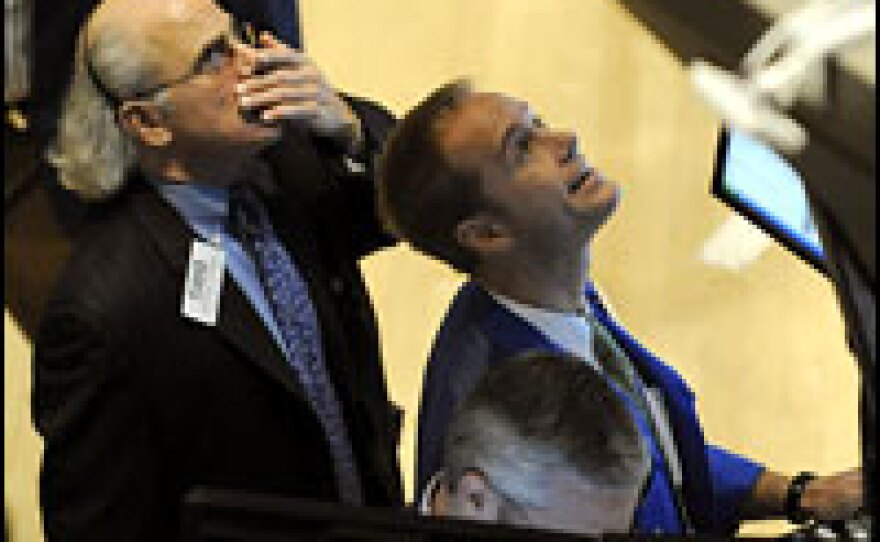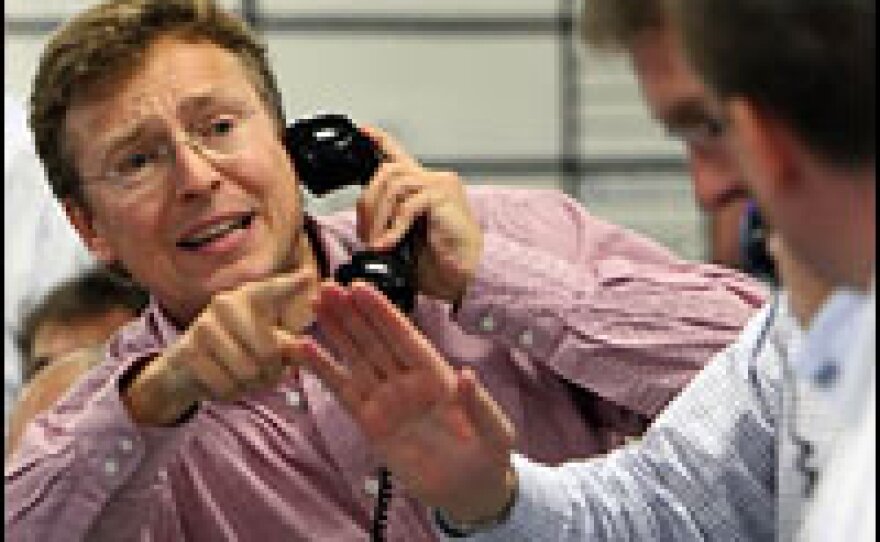


Futures trading is setting Wall Street up for a solid start on Thursday.
The Dow Jones industrial average futures index was up 136 points ahead of the opening bell in New York.
South Korea, Hong Kong and Taiwan followed the central banks in cutting interest rates.
European markets rose after Wednesday's coordinated global interest rate cut. Investors in Asia showed enthusiasm over the rate cuts, but markets were tempered by ongoing fears about the credit crunch and a possible recession worldwide.
Seeking to calm investors' jangled nerves Wednesday, Treasury Secretary Henry Paulson said U.S. policymakers stood ready to do whatever was necessary to tackle the worst financial crisis since the Great Depression.
"We will use all of the tools we've been given to maximum effectiveness, including strengthening the capitalization of financial institutions of every size," Paulson told reporters at the Treasury on Wednesday.
He said that the Treasury, the Federal Reserve and the Federal Deposit Insurance Corp. were ready to "use all their authorities to promote the process of repair and recovery and to contain the risks to the financial system that might arise from problems at individual institutions."
Central Banks Coordinate On Rate Cut
His comments came hours after the Federal Reserve and five other central banks announced a coordinated interest rate cut of half a percentage point. Paulson said that the rate cuts, once they worked their way into the financial system, would stabilize the financial sector, and a program the Fed announced earlier this week to buy commercial paper will "significantly improve the availability of funding for financial institutions and corporations that depend on the commercial paper market."
The rate cut was a bid to jump-start the ailing global economy, but what it ended up doing is spooking investors on Wall Street. They clearly didn't know what to think. Was the coordinated cut a sign that central banks were going to do whatever was necessary to prevent a deep global recession? Or was it a harbinger of still darker days ahead?
The markets were all over the place. At one point the Dow Jones industrial index was up as much as 181 points and then fell much as 252 points before closing down 189.01 at 9258.10.
Paulson Asks For Patience
After such a roller-coaster ride, investors were hoping the Treasury would announce an early start to the $700 billion bailout program. Instead, Paulson emerged Wednesday afternoon asking for their patience.
"The turmoil will not end quickly and significant challenges remain ahead," Paulson said as he outlined what the Treasury has done to start implementing the $700 billion financial rescue package Congress passed and the president signed last week. "Neither passage of this new law nor the implementation of these initiatives will bring an immediate end to current difficulties."
He said the Treasury was busy recruiting asset managers and other staff needed to carry out the rescue plan. But it would take some time to get that set up. It will be weeks before the Treasury will have everything in place to actually start buying the bad mortgages that financial institutions have on their books.
Paulson's comments came just two days before the Group of Seven Industrial Nations meets in Washington. This will be their first meeting since the financial crisis ignited last month. Paulson said that he wanted a special meeting of the finance officials from the Group of 20 as well. The Group of 20 includes both developed and emerging economies.
Since Monday, financial officials have been taking out their biggest guns in a bid to bolster investor confidence. The week began with the Treasury beefing up its team so it could implement the $700 billion package. The next day, the Federal Reserve announced that it would begin to buy commercial paper — the short-term loans that businesses need for their day-to-day operations — so it could inject some money into the frozen credit markets. Then U.S. investors woke up on Wednesday to a coordinated global rate cut.
A Glimmer of Hope?
In spite of all this movement, most eyes were still trained on the credit markets. The cost of borrowing dollars overnight in London has been soaring. The London Interbank Offered Rate, or LIBOR, which is the interest banks charge each other, jumped 144 basis points to 5.38 percent Wednesday, the British Bankers' Association said. That number, however, was set before the global rate cut was announced.
Investors saw a glimmer of hope in the fact that the interest-rate spreads squeaked a little lower. The two-year swap spread fell almost 1 basis point to 133 basis points. On Oct. 2, the swap spread was at 167.25 basis points, according to Bloomberg figures.
The simplest way to explain swap spreads is that they are the premium charged over Treasury yields. That premium is meant to essentially be the costs incurred to cover any risk. Treasuries, of course, are considered the safest investments because they are backed by the U.S. government.
Another key indicator of how the credit markets are doing is something called the "TED spread." That is the difference between what banks and the Treasury pay to borrow money for three months. According to Bloomberg figures, the spread is now at 387 basis points. Earlier Wednesday it had widened to 403 basis points. That's the biggest spread since Bloomberg began compiling data in 1984.
"I am not going to make predictions on the time it will take for the economy to recover," Paulson said. He said he was working to "mitigate" the financial impact the financial crisis would have on the economy.
Paulson warned not to read too much into the narrowing spreads. "It is too early to look for encouraging signs in the credit markets," he said. "It is going to take a while to work through this problem."
Fed Gives AIG New Loan
Meanwhile, soon after the U.S. financial markets closed, the Federal Reserve announced that it had agreed to provide insurance giant American International Group another loan of up to $37.8 billion. Just last month the government said it would lend AIG up to $85 billion in exchange for a nearly 80 percent equity stake in the company. The Fed said Wednesday that AIG needed more. So the Fed will borrow up to $37.8 billion in investment grade, fixed-income securities from AIG in return for cash collateral.
The Fed said the idea is to help AIG boost its liquidity because the company has already drawn down the $85 billion in the original emergency loan. To people following the AIG situation closely, the news isn't so surprising. Last Friday AIG's new CEO, Edward Liddy, told analysts that AIG had already drawn down $61 billion of the emergency bridge loan the Fed provided two weeks ago. The idea behind the loan was to allow AIG time to sell its troubled assets in an orderly way. Liddy said most of the original Fed loan had gone to shore up AIG's hobbled structured-finance unit and its securities-lending business.
Copyright 2022 NPR. To see more, visit https://www.npr.org. 9(MDAzMjM2NDYzMDEyMzc1Njk5NjAxNzY3OQ001))






